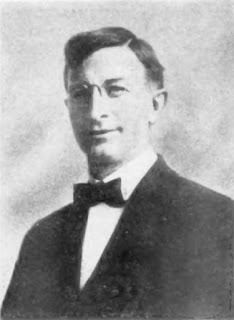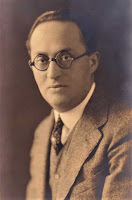He, and a twin brother Peter, were born in Peoria, Illinois, on 13 March 1934. He had a sister one year older, and a half-sister from his father's first marriage. His parents were John Harding Page Hughart, Jr. (1899-1963) and Annie Veronica Barry (1907-1977), who were married in Chicago in 1931. In the 1930 US Census, his father was listed as the manager of a lumber company, and in the 1940 US Census as a salesman for a pipe manufacturing company, while Hughart's Contemporary Authors entry notes his father was "a naval officer." (The father became a Captain in the U.S. Navy in World War II.) His mother (known familiarly as Veronica), according to her obituary in the Arizona Daily Star for 4 August 1977, was an artist, architectural designer, and former journalist. She had attended school in North Carolina, and lived in Illinois and Connecticut before moving to Arizona in 1941, where she operated a guest ranch near Bonita, Arizona, beginning in 1948. She and her family moved to Tucson in 1951. In the early 1950s she wrote a syndicated newspaper column titled "What a Woman Thinks."
Barry and his brother are known to have attended the Greenfield school in Arizona, and Barry also attended Andover in Connecticut, in the class of 1952. He went to Columbia University (A.B., 1956), and served in the U.S. Air Force from 1956-60. From 1960-63 he worked with a military surplus weapons supplier in the Near East, and from 1963-65 in the Far East. From 1965-70 he was manager at the Lenox Hill Book Shop in New York City, after which time he became a writer.
Hughart characterized his early life as follows in the flap copy of the 2008 Subterranean Press edition of the omnibus of The Chronicles of Master Li and Number Ten Ox:
 |
| Barry Hughart, Fear magazine 1989 |
When I got out of Andover in the 1950s I suffered from fairly severe depression, but this was back when the only such term recognized by the medical profession was 'depressive' following 'manic' which was one bad gig until some genius renamed it 'bipolar disorder' and after that it couldn't harm a fly. Since I wasn't lucky enough to qualify for manic and clinical depression didn't exist they diagnosed schizophrenia and packed me off to a booby hatch. (Which was not entirely a bad thing. Man, the scene at Kings Count Psychotic Ward was like awesome!) Then I was promoted to a slightly less odorous asylum where Doctor Oscar Diethelm expounded upon the delights of going snickety-snick on my frontal lobes, and while it would take too long to explain I managed to escape to Columbia University. There I found myself groping through weird landscapes obscured by clouds of pot behind which pimpled prophets of the Beat Generation shrieked, 'Our minds destroyed by madness, starving, hysterical, naked, dragging through black streets at dawn looking for an angry fix, or what the fuck, something like that. Yo, daddy-o!' and I said to myself, 'Barry, you have found a home.'
When I wafted back into the world a few years later my depression was still there but I was allowed to prove my sanity by blowing things up for the U.S. Air Force. No, not Vietnam. Planting ingenious and mostly illegal mine fields around the eternal DMZ in Korea. Time passed but not much else. I moved to the Arizona/Sonoran Desert where I could live quietly, surrounded on all sides by prickly pear, cat's claw, devil's horns, barrel cactus, jumping cactus, and illegal immigrants. I still occasionally dreamed of bright flashes followed by BOOM! which was a shame because I had other memories of the Far East: good memories, warm memories, and in 1977—ten years before Prozac—I decided to use those and whatever else I could come up with to create an alternate world into which I could creep on dark and stormy nights and pull over my head like a security blanket. So I read a lot and scribbled a lot and gradually the land of Li Kao began to take shape. But the first draft of Bridge of Birds didn't really work and I couldn't see what was wrong, so I dumped it into a drawer for a few years. Then one day I read Lin Yutang's The Importance of Understanding and found the prayer to a little girl that I mention in a footnote in the final version. It made me realize that while I'd invented good things like monsters and marvels and mayhem the book hadn't really been about anything. I opened the drawer. 'Okay!' I said to myself. 'This book is going to be about love.' And so it is, and so are ones that followed
The original draft of The Bridge of Birds is online here.
It was printed as a standalone trade paperback volume to the slipcased
edition, limited to 200 copies, of the 2008 Subterranean Press omnibus, The Chronicles of Master Li and Number Ten Ox.
According to Hughart, the rewritten Bridge of Birds was turned down by 17 publishers before it finally sold to St. Martin's Press as a straight novel. A reader at Alfred Knopf returned the manuscript with a haughty comment: "This is not historically accurate!" Hughart noted: "Paperback rights were sold to Del Rey thanks to Anne McCaffrey, who was solicited for a comment on the hardcover, loved the book, and later pressed it on to Judy-Lynn Del Rey in a New York taxi" (Locus, December 1985). Thus, rather reluctantly, he became a fantasy author, though he felt that his books were more adventure or detective stories.
In an interview with Jerry Kuntz from January-February 2000, Hughart reflected:
The master Li books were a tightrope act and hard to write, but not, alas, very remunerative. Still, I would have continued as originally planned if I'd had a supportive publisher: seven novels ending with my heroes' deaths in the battle with the Great White Serpent, and their elevation to the Great River of Stars as minor deities guaranteed to cause the August Personage of Jade almost as much trouble as the Stone Monkey. Unfortunately I had St. Martins, which didn't even bother to send a postcard when I won the World Fantasy Award; Ballantine, which was dandy until my powerhouse editor dropped dead and her successors forgot my existence; and Doubleday, which released The Story of the Stone three months before the pub date, guaranteeing that not one copy would still be on the shelves when reviews came out, published the hardcover and the paperback of Eight Skilled Gentlemen simultaneously, and then informed me they would bring out further volumes in paperback only, meriting, of course, a considerably reduced advance.
That put an end to the series, and one can't really blame Hughart for stopping.
There remain some mysteries of Hughart's bibliography yet to be solved.
In the Locus profile from December 1985, it states: The
Bridge of Birds was “the first novel Hughart published under his own name,
but he had previously written two pseudonymous novels which he now dismisses as
‘terrible—I’ve done with them and want to forget them.’” He clarified this a bit in his 1992 Contemporary Authors entry, noting he was "also author of screenplay for Bridge of Birds, and 'a couple of early novels under pseudonyms: out of print, unlamented, and the author prefers to forget them." But what are they about, and what are the pseudonyms?
In the profile of Hughart in the May/June 1989 issue of Fear,
it is noted: “Despite the odd-job existence in the Far East, Hughart enjoyed
writing: he did not intend to be a novelist but would have liked to have been a
poet and, indeed, some of his verse did see publication.” Publication where? His Contemporary Authors entry notes that he was a "contributor of articles to periodicals, including Village Voice." But none of these contributions are known.
Also in his Contemporary Authors entry, Hughart noted that he “worked as dialogue writer for films, including Devil’s Bride, Honeymoon with a Stranger, Man on the Move, The Other Side of Hell, Welcome Home Johnny Bristol, Snow Job, Special Effects, and When the Bough Breaks. Some of these were released as films---e.g., Honeymoon with a Stranger (1969), Welcome Home, Johnny Bristol (1972), Snow Job (1972), but Hughart’s input was likely minimal.
He did, however, write three known screenplays in this time period, whose copyright was registered with the Copyright Office in Washington, D.C. These include “The Idol’s Eye” 68 pp., October 1970; “Sing along with Billy Blake” 121 pp., including lyrics for one song, November 1971; and “Enemies of the People” 150 pp. March 1973. All three are unproduced.
Again from his Contemporary Authors entry, he noted as his "work in progress": "Writing a novel, Dancing Girl, and preparing a screenplay for the work; continuously researching ancient China." None of these ever appeared.
Finally, a recommendation for the Barry Hughart Bibliography, a website maintained by Mike Berro, an invaluable resource. See here. And it also hosts the interview with Hughart by Jerry Kuntz, January-February 2000, cited above. Accessible here.











